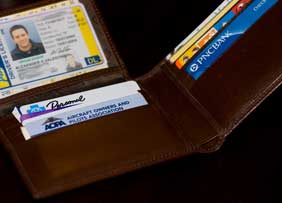 Let’s say you’re buying a latte at a coffee shop. You dig into your purse but discover you’re out of cash. So you pluck a debit card from your wallet, wave it in the air and ask the barista, “Can I use this?”
Let’s say you’re buying a latte at a coffee shop. You dig into your purse but discover you’re out of cash. So you pluck a debit card from your wallet, wave it in the air and ask the barista, “Can I use this?”
Stop.
To you this seems like a tiny, unimportant moment of your day. But to the coffee shop, it could mean the difference between making a profit, or selling the latte at a loss. And to the nation’s largest merchants and banks, this little decision, repeated millions of times every day across the country, lies at the very heart of a titanic and expensive battle in Congress between retailers on one side, banks and credit card networks on the other.
The winning side will see an annual windfall of at least $24 billion.
“It’s huge right now,” says Ed Mierzwinski, director of the consumer program at the U.S. Public Interest Research Group (PIRG) in Washington, D.C. “Probably every lobbying firm in the city is getting paid because of this.”
The fight is over the dry-sounding Durbin Amendment, scheduled to go into effect April 21, and the even drier-sounding issue of “interchange fees.” Under rules proposed by the Federal Reserve, the fees that banks charge merchants for processing debit card transactions would be cut 84%, and capped at a maximum of 12 cents (the current average is around 44 cents).
[Resource: Credit.com’s Consumer Guide to the Proposed Debit Interchange Rule]
Banks are fighting the change, and the outcome of the battle could change the way we buy everything from gas to groceries.
“Why should consumers care?” says Trish Wexler, spokeswoman for the Electronic Payments Coalition, which represents banks and the credit card networks in this fight. “Because the debit card as they know and live it today is about to change.”
That is, unless Wexler and her coalition can stop it.
Interchange Made Easy
Okay, let’s start with the basics. What’s an interchange fee? It’s the fee the merchant pays every time you swipe your debit card. If you swipe your card to spend $100 at the grocery store, you probably assume the store gets to keep the full $100.
They don’t. They only get $98.30, because an average of $1.70 covers the interchange fee, according to a report by the Federal Reserve. That money is divided between your bank, the grocery store’s bank, and the network that supplies the card swipe machine. Visa and MasterCard run the dominant networks, with American Express and Discover running a distant third and fourth respectively.
That $1.70 average fee charged for every $100 spent applies only to debit card transactions that the customer authorizes with a signature. These transactions occur over the major credit card networks. They cost retailers slightly less than the cost of processing credit card transactions. Alternatively, the customer can swipe the same debit card, but enter a PIN number instead of a signature. This type of transaction occurs electronically and immediately. These transactions are processed over different networks (such as Pulse, Star, or NYCE as well as MasterCard’s Maestro and Visa’s Interlink). This type of transaction costs retailers a lot less, usually around 15 cents.
[Related: Fed Proposal Would Cut Debit Card Fees by 70%]
Two different payment methods using the same card fosters plenty of jockeying between banks and retailers. Because PIN-based transactions cost retailers significantly less money, they try to encourage those purchases, often by automatically prompting customers to enter a PIN on the terminal where they swipe their cards. Meanwhile, banks offer rewards for signature-based transactions, and a few charge their customers a fee for every PIN transaction.
Either way, a debit purchase is like using a digital check, only it’s faster for consumers, merchants and banks.
That convenience may explain why Americans’ debit card purchases surged from $210 billion in 2000 to $637 billion in 2006, according to the Fed study. And most consumers have no idea the fee is there, buried in the price of items they buy every day.
“I think that a lot of us, particularly in younger generations, have started to use debit as cash for the convenience and security,” Wexler says.
Image by alexvalentine, via Flickr
You Might Also Like
March 11, 2021
Personal Finance
March 1, 2021
Personal Finance
February 18, 2021
Personal Finance





